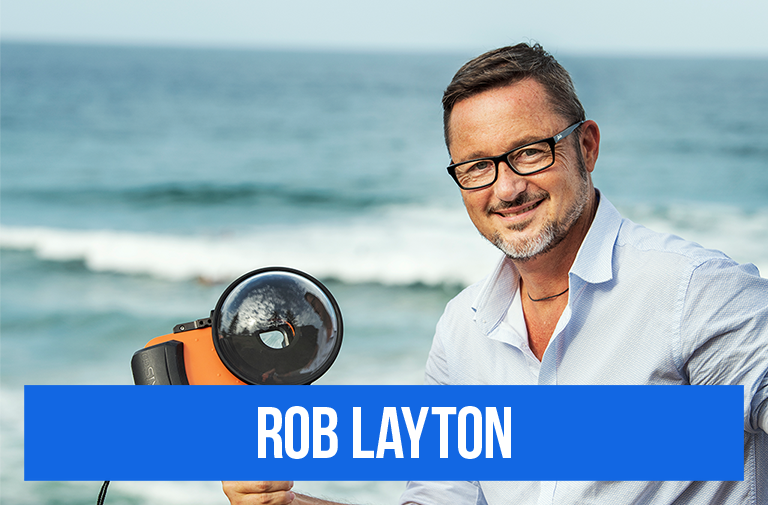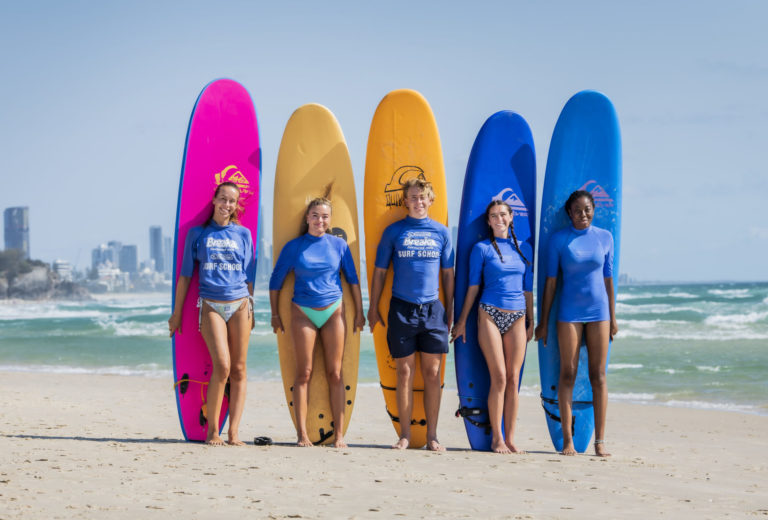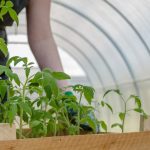Bond University students have immersed themselves in Gold Coast surf culture in a new course that is the only one of its kind in Australia.
Students undertaking the subject Gold Coast Surf, Culture, and Storytelling explore the region’s rich surfing history and heritage, with course convenor Assistant Professor Rob Layton saying it is an opportunity for students to learn by experience.
Classes include learning to surf with former pro surfer Munga Barry’s school, and other field trips including visiting Coolangatta’s World Surf League headquarters, as well as the Mt Woodgee surfboard factory at Currumbin.
Surf videography and photography using smartphones is also part of the curriculum, with students able to practice in the Bond University pool before taking their devices to the waves.
With his background as a career journalist, Mr Layton transitioned into teaching journalism subjects at the university and was motivated to create the course after working on a PhD about Gold Coast surf culture.

The genesis of the subject, he says, is “quite unique” after he applied “due diligence” and discovered that, although surfing is explored in some university curriculums, a course that focuses on the sub-culture and ethnography is unusual – and in Australia, it’s groundbreaking.
“In Hawaii they do something about the cultural aspect of surfing, but this is about the unique culture of the Gold Coast region – Burleigh Heads, specifically,” Mr Layton told EducationDaily.
Students become researchers who immerse themselves in a social setting to better understand that social phenomenon.
“In this case, it’s surfing.”
A tidal wave of interest
When Bond University introduced the course this semester, Mr Layton says he wasn’t sure exactly how many people would be interested in it and so the university tested the waters by opening up just one class, originally capped at 30 students.
“Somehow another five students made their way in, he says, “and then we were inundated with requests”.
Of the 35 current students, he says 28 of them are international, with many from Scandinavian countries, including Norway, Sweden and Denmark visiting for just one semester as part of their tertiary studies in their homeland.
Bond University enables degree students to take any subject they like as an elective, which means some of the students studying surfing are on their way to careers in business or law.
“For most of them, it’s their first experience of surfing,” he says.

Celebrating local surf culture heritage
Mr Layton, who surfs Burleigh Heads every day, says he’s been a passionate advocate about his city’s surfing heritage for a long time and sees this course as a meaningful exploration of that rich history.
“I have been part of the Burleigh community for a long time, so local surfers have been more than happy to talk with the students and give their perspectives.”
“We don’t celebrate it as much as other cities do,” he says, highlighting the way surfing culture is proudly promoted in many iconic California cities and towns.
The 12-week course consists of 12 modules, with the first three weeks comprising what Mr Layton describes as “the scaffolding” that introduces students to the concept of surf culture.
In each subsequent week and module, the students are then given the opportunity to be more hands-on and go deeper, with classes also covering the legend of local surfing superstars, including Joel Parkinson, Steph Gilmore and Mick Fanning.
“We watched the documentary Bustin’ Down the Door, about the formation of pro surfing, and to then have Rabbit Bartholomew turn up the next week, the students were star-struck,” Mr Layton says.
Exploring links between place and identity
On the academic side of the surf culture studies, the students learn how to write an ethnography and how to interpret data they uncover in the field.
“They learn about what a sub-culture is, what identifies a sub-culture and how to identify patterns in sub-cultures,” he told EducationDaily.
Part of that understanding, he says, is knowing the importance of the relationship between place and identity.
Being exposed to the long history of the First Nations people of the area is another important part of the course that focuses on the Indigenous salt water culture.
“We are very fortunate at Bond to have a highly respected Indigenous Elder on staff. Uncle John Graham took students for a cultural awareness walk of Jellurgal (Burleigh), shared Dreaming stories, and explained the cultural and spiritual importance of the place to Aboriginal people,” he says.
“We wanted to bring in Aboriginal culture and show respect that they were here first, and it was a very important place for them. When we show students a midden, they can’t believe there are shells that have been put here by people so many thousands and thousands of years before.”
That experience, he hopes, aims to teach an abiding respect for the land – and, ultimately, “respect for yourself”.
Developing greater empathy and understanding
“The students are so grateful,” he told EducationDaily. “They are just gobsmacked at what they’ve been given. It’s really just about introducing them to another culture from another culture’s perspective. When you have a better understanding of how other people live, you have a greater empathy for the world around you – and that’s a good thing.”
“Many have told me that taking this subject has been life-changing, that it has given them a deeper understanding of a culture they knew little about.
The more we can broaden our thinking, and understand how other people live, surely that has to help make the world just that little bit better.”








